partC英语听力速记技巧
- 格式:doc
- 大小:21.50 KB
- 文档页数:3

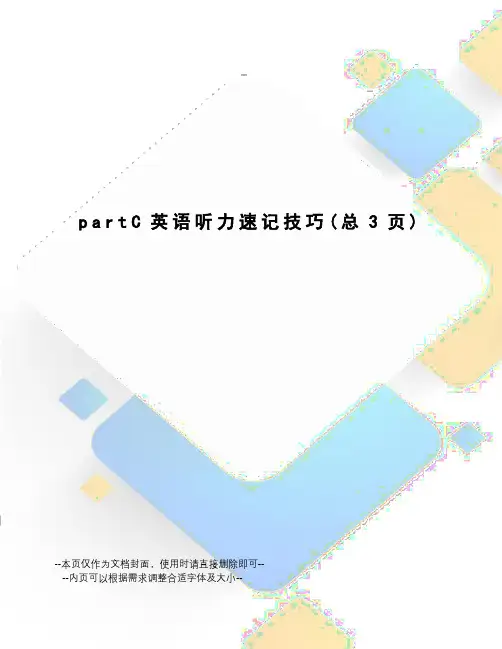
p a r t C英语听力速记技巧(总3页)--本页仅作为文档封面,使用时请直接删除即可----内页可以根据需求调整合适字体及大小--英语听力速记技巧1. 养成立即复述的习惯在平时训练听录音时以仅落后1-2秒的速度紧跟其后,出声朗读,以帮助强化记忆,同时进行理解并做记录。
2. 学会做笔记记笔记的方式可因人而异。
你可以尽可能多地记下文中所提及的人名、地名、各种数据、事实和理由等你认为重要的信息。
好的笔记应是对所听内容作出的简要提纲,可以用关键词,也可以用短语或句子来表示,关键是要简洁、明白、快捷。
How to take notes quickly?如何快速做笔记?as many symbols(符号)as you feel comfortable with.abbreviations(缩写词).Chinese characters(中文).下面是一些常用的技巧可供大家学习时参考。
(1)灵活使用简单符号传达意思,如:◆“↑”可用来记录“up, upward, rise, arise, develop, increase, rocket, make progress”等词或短语。
如短语“economic development”可记作“e↑”。
◆“↓”可用来记录“drop, sink, decline, descend, sudden fall, decrease, reduce, cut down, go down”等词或短语。
◆“←”可用来记录“return, reverse, back up”等词或短语。
◆“→”可用来记录“achieve, get to, arrive, teach, obtain, bring on, go forward, go ahead, progress, make for”等词或短语。
◆“+”可用来记录“plus, add, enhance, male, more”等词或短语。
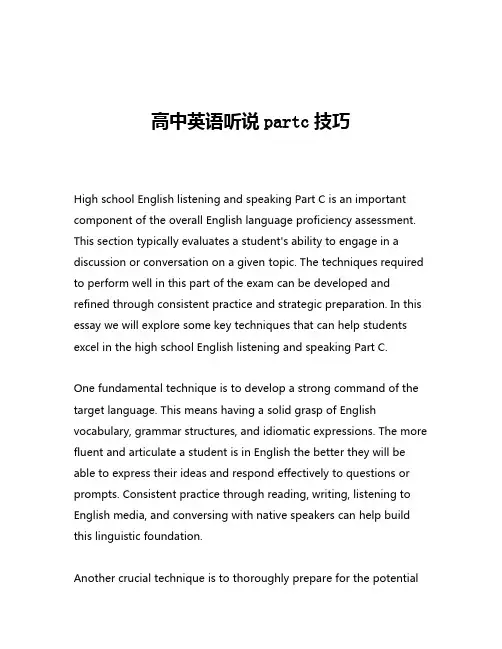
高中英语听说partc技巧High school English listening and speaking Part C is an important component of the overall English language proficiency assessment. This section typically evaluates a student's ability to engage in a discussion or conversation on a given topic. The techniques required to perform well in this part of the exam can be developed and refined through consistent practice and strategic preparation. In this essay we will explore some key techniques that can help students excel in the high school English listening and speaking Part C.One fundamental technique is to develop a strong command of the target language. This means having a solid grasp of English vocabulary, grammar structures, and idiomatic expressions. The more fluent and articulate a student is in English the better they will be able to express their ideas and respond effectively to questions or prompts. Consistent practice through reading, writing, listening to English media, and conversing with native speakers can help build this linguistic foundation.Another crucial technique is to thoroughly prepare for the potentialtopics and discussion points that may arise in the Part C assessment. While the exact topic may not be known in advance, students can research and familiarize themselves with a range of subjects that are commonly covered such as current events, social issues, academic subjects, and personal experiences. By having a broad base of knowledge on these types of topics, students will be better equipped to engage in a thoughtful and coherent discussion.In addition to topical knowledge, students should also practice formulating clear and well-structured responses. This involves being able to succinctly state one's opinions, provide relevant supporting details, and logically organize one's thoughts. Techniques such as using transitional phrases, providing examples, and anticipating potential counterarguments can help students deliver polished and persuasive responses.Active listening is another critical skill for success in the high school English listening and speaking Part C. Students must not only be prepared to speak, but also demonstrate the ability to actively listen to the interviewer's questions or prompts, and respond accordingly. This requires paying close attention, seeking clarification when needed, and tailoring one's responses to address the specific points raised.Effective time management is also an important technique for thisassessment. Students must be able to pace themselves, ensuring that they provide thorough and thoughtful responses within the allotted time frame. This may involve practicing concise and efficient speech, prioritizing key points, and being mindful of time constraints.Finally, confidence and poise are essential qualities that can greatly impact a student's performance in the high school English listening and speaking Part C. Students should strive to project an air of self-assurance, even if they feel nervous. Techniques such as deep breathing, positive self-talk, and visualizing success can help students manage their nerves and present themselves in the most favorable light.In conclusion, the high school English listening and speaking Part C assessment requires a multifaceted set of skills and techniques. By developing a strong command of the English language, thoroughly preparing for potential topics, practicing clear and well-structured responses, demonstrating active listening, managing time effectively, and projecting confidence, students can maximize their chances of success in this important component of the overall English proficiency evaluation. Through consistent practice and the application of these techniques, students can develop the necessary competencies to excel in the high school English listening and speaking Part C.。
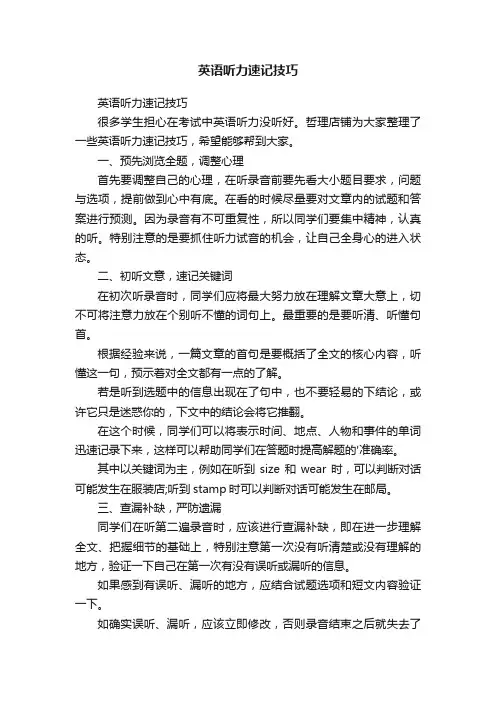
英语听力速记技巧英语听力速记技巧很多学生担心在考试中英语听力没听好。
哲理店铺为大家整理了一些英语听力速记技巧,希望能够帮到大家。
一、预先浏览全题,调整心理首先要调整自己的心理,在听录音前要先看大小题目要求,问题与选项,提前做到心中有底。
在看的时候尽量要对文章内的试题和答案进行预测。
因为录音有不可重复性,所以同学们要集中精神,认真的听。
特别注意的是要抓住听力试音的机会,让自己全身心的进入状态。
二、初听文意,速记关键词在初次听录音时,同学们应将最大努力放在理解文章大意上,切不可将注意力放在个别听不懂的词句上。
最重要的是要听清、听懂句首。
根据经验来说,一篇文章的首句是要概括了全文的核心内容,听懂这一句,预示着对全文都有一点的了解。
若是听到选题中的信息出现在了句中,也不要轻易的下结论,或许它只是迷惑你的,下文中的结论会将它推翻。
在这个时候,同学们可以将表示时间、地点、人物和事件的单词迅速记录下来,这样可以帮助同学们在答题时提高解题的'准确率。
其中以关键词为主,例如在听到size和wear时,可以判断对话可能发生在服装店;听到stamp时可以判断对话可能发生在邮局。
三、查漏补缺,严防遗漏同学们在听第二遍录音时,应该进行查漏补缺,即在进一步理解全文、把握细节的基础上,特别注意第一次没有听清楚或没有理解的地方,验证一下自己在第一次有没有误听或漏听的信息。
如果感到有误听、漏听的地方,应结合试题选项和短文内容验证一下。
如确实误听、漏听,应该立即修改,否则录音结束之后就失去了解题的依据。
四、解题复查,高分稳拿其实很多时候只要同学门认真听录音就能够准确作答,只是有一小部分不能直接听到答案,在无法直接做出选择时,应进行逻辑推理,必要时可以将答案全部写在纸上,根据内容进行推理。
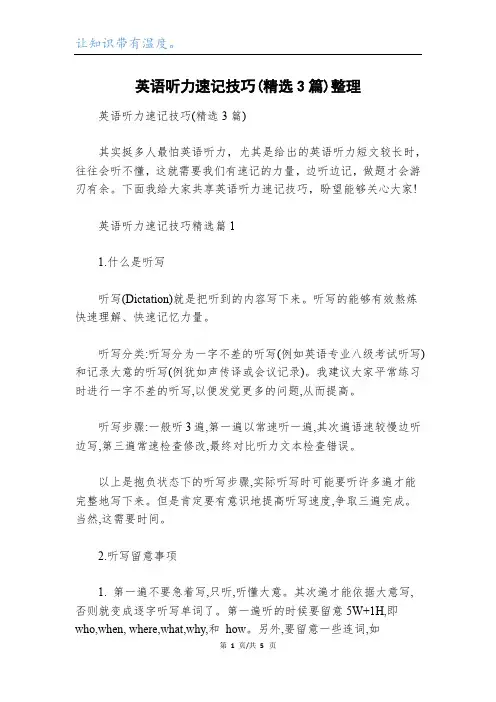
英语听力速记技巧(精选3篇)整理英语听力速记技巧(精选3篇)其实挺多人最怕英语听力,尤其是给出的英语听力短文较长时,往往会听不懂,这就需要我们有速记的力量,边听边记,做题才会游刃有余。
下面我给大家共享英语听力速记技巧,盼望能够关心大家!英语听力速记技巧精选篇11.什么是听写听写(Dictation)就是把听到的内容写下来。
听写的能够有效熬炼快速理解、快速记忆力量。
听写分类:听写分为一字不差的听写(例如英语专业八级考试听写)和记录大意的听写(例犹如声传译或会议记录)。
我建议大家平常练习时进行一字不差的听写,以便发觉更多的问题,从而提高。
听写步骤:一般听3遍,第一遍以常速听一遍,其次遍语速较慢边听边写,第三遍常速检查修改,最终对比听力文本检查错误。
以上是抱负状态下的听写步骤,实际听写时可能要听许多遍才能完整地写下来。
但是肯定要有意识地提高听写速度,争取三遍完成。
当然,这需要时间。
2.听写留意事项1. 第一遍不要急着写,只听,听懂大意。
其次遍才能依据大意写,否则就变成逐字听写单词了。
第一遍听的时候要留意5W+1H,即who,when, where,what,why,和how。
另外,要留意一些连词,如so,but,however,therefore等,这些词反映句子及文章结构,往往也与文章中心容相关。
2. 其次遍听写时重点写实词(有实际意义的词),如动词、名词、代词、形容词、副词、数词等。
而虚词(如词、冠词、连词、冠词等),因时间有限,可在第三遍或之后进行补充。
另外,听写时可以用速记符号、字母或缩来代替单词,以提高听写速度。
例如:用≈表示about,表示more than,IMP表示important,INFO表示information,R表示are,U表示you。
更多缩写可点击此处查看,网上有许多源,大家可以搜一搜。
3. 第三遍补充漏写的单词,检查拼写、语法、标点等错误。
最终要把符号或缩写替换成单词。
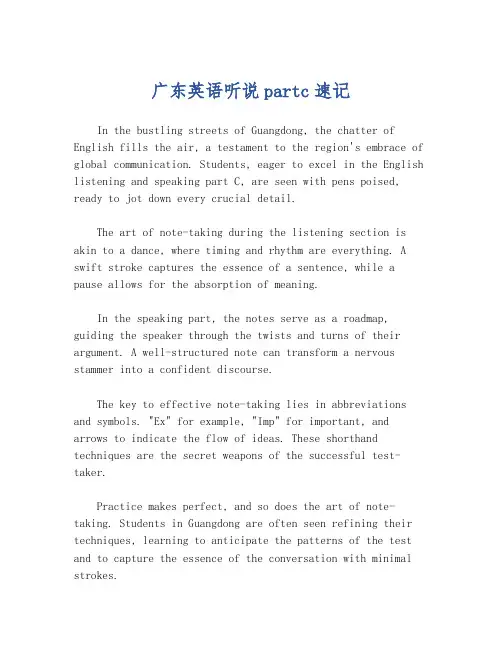
广东英语听说partc速记In the bustling streets of Guangdong, the chatter of English fills the air, a testament to the region's embrace of global communication. Students, eager to excel in the English listening and speaking part C, are seen with pens poised, ready to jot down every crucial detail.The art of note-taking during the listening section is akin to a dance, where timing and rhythm are everything. A swift stroke captures the essence of a sentence, while a pause allows for the absorption of meaning.In the speaking part, the notes serve as a roadmap, guiding the speaker through the twists and turns of their argument. A well-structured note can transform a nervous stammer into a confident discourse.The key to effective note-taking lies in abbreviations and symbols. "Ex" for example, "Imp" for important, and arrows to indicate the flow of ideas. These shorthand techniques are the secret weapons of the successful test-taker.Practice makes perfect, and so does the art of note-taking. Students in Guangdong are often seen refining their techniques, learning to anticipate the patterns of the test and to capture the essence of the conversation with minimal strokes.Speed and accuracy are the twin pillars of successfulnote-taking. The ability to quickly write down key points without sacrificing clarity is what sets apart the proficient from the novice.In the competitive world of English proficiency tests, every second counts. A well-timed note can be the difference between a passing grade and a missed opportunity.The final tip for mastering the art of note-taking in the English listening and speaking part C is to stay calm and focused. Even in the heat of the moment, a clear mind can discern the important from the trivial.As the test concludes, the notes become a reflection ofthe student's journey. A tapestry of scribbles, each one astep towards fluency and understanding in the global language.。
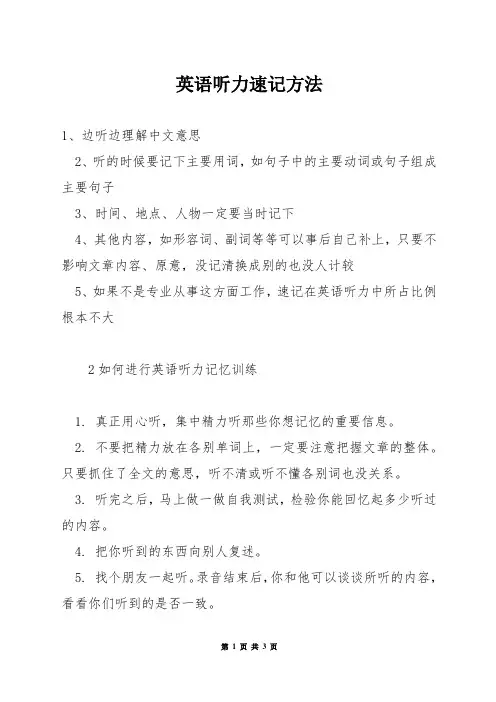
英语听力速记方法1、边听边理解中文意思2、听的时候要记下主要用词,如句子中的主要动词或句子组成主要句子3、时间、地点、人物一定要当时记下4、其他内容,如形容词、副词等等可以事后自己补上,只要不影响文章内容、原意,没记清换成别的也没人计较5、如果不是专业从事这方面工作,速记在英语听力中所占比例根本不大2如何进行英语听力记忆训练1. 真正用心听,集中精力听那些你想记忆的重要信息。
2. 不要把精力放在各别单词上,一定要注意把握文章的整体。
只要抓住了全文的意思,听不清或听不懂各别词也没关系。
3. 听完之后,马上做一做自我测试,检验你能回忆起多少听过的内容。
4. 把你听到的东西向别人复述。
5. 找个朋友一起听。
录音结束后,你和他可以谈谈所听的内容,看看你们听到的是否一致。
6. 如果你想隔较长时间再回忆你所听的内容,那么你最好把你所听的要点记录下来。
这里又提到了一个作笔记的问题。
听音时作笔记也是帮助我们理解听力材料的一个好方法,它可以提升区分有用信息和无用信息的能力。
更重要的一点还在于它能帮我们减轻大脑的负担,完整而准确的把握所听材料的主要内容。
记笔记的方式可因人而异。
你可以在选择项旁边尽可能地记下文中所提及的人名、地名、各种数据、事实和理由等你认为重要的信息。
3英语听力如何做到边听边记留意句子中的重读音处,往往为句子的核心含义所在首先重点听段落的首尾句,尤其要留意文中的高频率的词汇,往往为文章主旨,必须要记下,可以以其首字母或者前两个字母来代替注意听力中首尾屡次重复的名词,往往为文章的主要内容同样一些具有方向性的词语也可以使用符号记录,比如increase可以使用代替,decrease使用等留意文中的逻辑连词,以及语气变化处必须要记录,,这时可以使用符号记录,比如but可以使用,and可以使用等碰到时间,数字等单词时,直接使用阿拉伯数字或者缩写来代替,比如eight in the morning可以记作8 a.m4英语听力技巧(一) 听前(pre-listening)听力考试前必须稳定情绪,做好听音的准备工作。
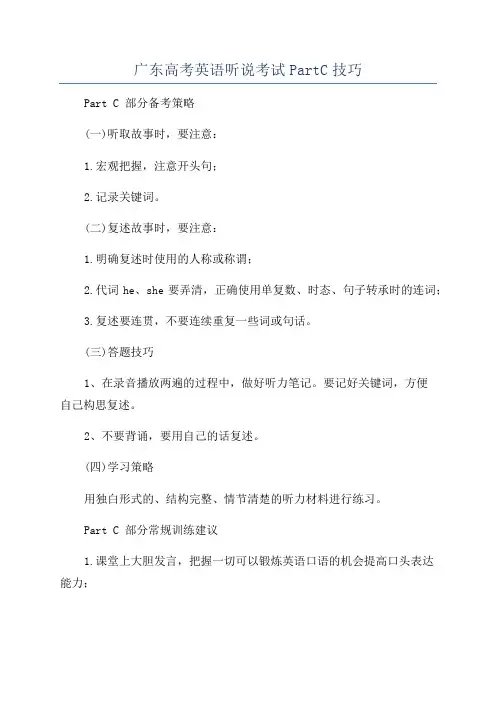
广东高考英语听说考试PartC技巧Part C 部分备考策略(一)听取故事时,要注意:1.宏观把握,注意开头句;2.记录关键词。
(二)复述故事时,要注意:1.明确复述时使用的人称或称谓;2.代词he、she要弄清,正确使用单复数、时态、句子转承时的连词;3.复述要连贯,不要连续重复一些词或句话。
(三)答题技巧1、在录音播放两遍的过程中,做好听力笔记。
要记好关键词,方便自己构思复述。
2、不要背诵,要用自己的话复述。
(四)学习策略用独白形式的、结构完整、情节清楚的听力材料进行练习。
Part C 部分常规训练建议1.课堂上大胆发言,把握一切可以锻炼英语口语的机会提高口头表达能力;2.充分利用课堂教学素材,选取故事性较强的文章或段落进行复述训练;3.有意识地培养速记的能力,积累丰富有效的速记符号;4.礼用旧题型的听力材料,进行听说训练。
忽略旧题型的选项部分,一边听一边记录要点,训练听取大意、获取要点以及已记录要点的能力,同时用自己的语言进行复述,强化故事复述能力的培养。
【考试时】高分技巧1.录音不宜太心急,一到录音时间就开始录音。
Is James interested in music like you?2.大声说英语从阅卷经验看,在每一部分的考试中,考生只要能说出相关的英语,回答的不管是一个一个短语,还是一个并不是很完整的句子,都会给分。
以2023真题Part B 为例。
Play the piano and violin. (得满分2 分)Piano and violin. (至少得1-1.5 分)Play piano/ violin. (起码有1 分)Piano/violin(起码有0.5 分)有把握时,请把句子说完整;把握不大时,说出句子的部分甚至一个关键的词也是很好的。
在回答Why....? 句子时,用了Because....来回答;在回答How many...?句子时,用了There are/ is...来回答,一样能得些分。
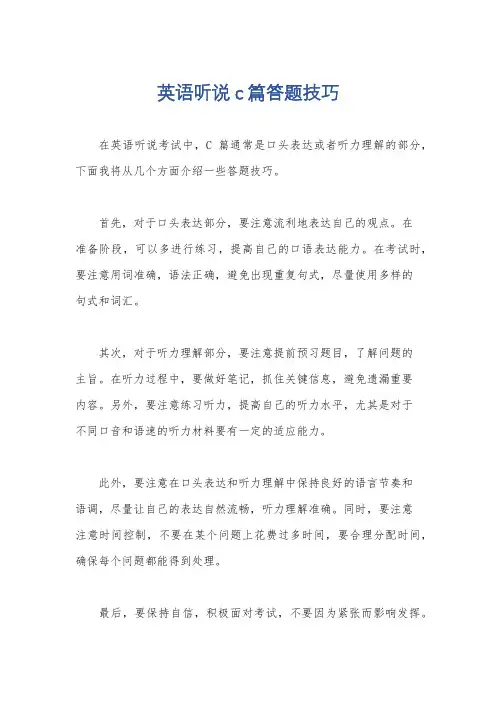
英语听说c篇答题技巧
在英语听说考试中,C篇通常是口头表达或者听力理解的部分,下面我将从几个方面介绍一些答题技巧。
首先,对于口头表达部分,要注意流利地表达自己的观点。
在
准备阶段,可以多进行练习,提高自己的口语表达能力。
在考试时,要注意用词准确,语法正确,避免出现重复句式,尽量使用多样的
句式和词汇。
其次,对于听力理解部分,要注意提前预习题目,了解问题的
主旨。
在听力过程中,要做好笔记,抓住关键信息,避免遗漏重要
内容。
另外,要注意练习听力,提高自己的听力水平,尤其是对于
不同口音和语速的听力材料要有一定的适应能力。
此外,要注意在口头表达和听力理解中保持良好的语言节奏和
语调,尽量让自己的表达自然流畅,听力理解准确。
同时,要注意
注意时间控制,不要在某个问题上花费过多时间,要合理分配时间,确保每个问题都能得到处理。
最后,要保持自信,积极面对考试,不要因为紧张而影响发挥。
要相信自己的平时积累和准备,尽量放松心态,全神贯注地完成考试。
总的来说,英语听说C篇的答题技巧包括口头表达和听力理解两个方面,要注重综合能力的提高,平时多加练习,保持自信,相信自己一定能够取得好成绩。
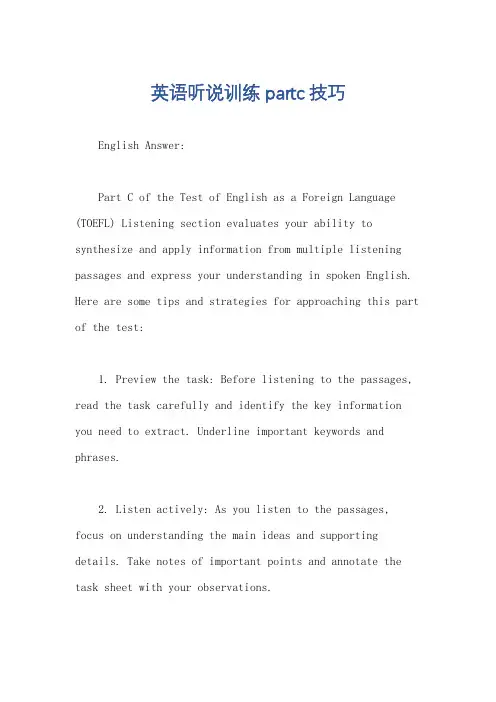
英语听说训练partc技巧English Answer:Part C of the Test of English as a Foreign Language (TOEFL) Listening section evaluates your ability to synthesize and apply information from multiple listening passages and express your understanding in spoken English. Here are some tips and strategies for approaching this part of the test:1. Preview the task: Before listening to the passages, read the task carefully and identify the key information you need to extract. Underline important keywords and phrases.2. Listen actively: As you listen to the passages, focus on understanding the main ideas and supporting details. Take notes of important points and annotate the task sheet with your observations.3. Identify the connections: Pay attention to how the passages relate to each other and to the task question. Note any similarities, differences, or contradictions in the information presented.4. Plan your response: Once you have listened to all the passages, take a few moments to plan your spoken response. Organize your thoughts and determine the most relevant information to include.5. Use clear and concise language: In your spoken response, use clear and concise language that accurately conveys your understanding of the passages. Avoid using filler words or repeating yourself unnecessarily.6. Practice speaking: Regularly practice speaking in English to improve your fluency and confidence. This can involve reading aloud from passages, having conversations with a tutor or language partner, or recording yourself and listening back to your speech.7. Time management: Be mindful of the time you have tocomplete the task. Use your time wisely by listening attentively to the passages and planning your response efficiently.中文回答:托福听力 Part C 技巧。

英语听说考试信息转述速记技巧
英语听说考试信息转述速记技巧:
1. 学会用简单的符号代替复杂的信息。
例如,使用箭头表示方向,用星星表示重要的事物,用波浪线表示过程或流程等。
2. 学会简化句子结构,用短语代替完整的句子。
例如,“go to the store”可以简化为“grocery run”。
3. 学会使用缩写和简写,例如,“U”代替“you”,“thnks”代替“thanks”,“cuz”代替“because”等。
4. 抓住关键信息,不要试图记下所有的细节。
重点记录开头和结尾,因为这些部分通常包含最重要的信息。
5. 学会使用固定的格式或模板,以便快速整理和回忆信息。
例如,在记录电话号码时,可以采用“(区号)-(前号)-(后号)”的格式。
6. 练习速记技巧,通过反复练习和实践,提高速记速度和准确性。
可以在平时的英语学习中加入速记练习,例如在听英语新闻或看电影时尝试记录关键信息。
7. 保持整洁的笔记,以便于后续的回顾和理解。
可以使用颜色编码、大写字母、下划线等方式突出关键信息。
以上技巧可以帮助你快速记录和整理英语听说考试中的信息,提高你的记忆力和理解能力。
英语听力笔记速记的技巧分析英语的听力一般是比较快的,想要完全记下来是不可能的,学生要学会速记,下面店铺的小编将为大家带来英语听力笔记速记速记的介绍,希望能够帮助到大家。
英语听力笔记速记的技巧1、不要大量记录文字(汉字、单词)——而要使用符号来表示意思(缩写、图形)Eg:“powerful country”记作“强口”,“我同意”记作“I√ ”;“观点,看法一致”记作“⊙ same”,“economic development”记作“经↑”↑表示“上升、快速上升、快速发展、快速上涨等”↓表示“下降、减少、急剧下降、急速下跌等”;↗表示“缓慢上升,缓慢发展、缓慢上涨等”;←表示“返回,倒退等”;→表示“达到,至,导致,前进等”;+表示“加,增加,此外,另外,又加之”;—表示“减少,减”;>表示“多于,大于,强于”;<表示“少于,小于,不如”;∵表示“因为,由于”;∴表示“所以,因此”;=表示“等于,相同,与……相同”。
t表示thousand; m;表示million;b表示 billion;1st表示first。
2、不要横着写:——而要竖着写,竖起来记有利于保持活意思意思以及数量等信息之间的逻辑界限。
3、逻辑关系要清楚明了——不要记流水帐。
高考英语听力速记的技巧1)运用速记符号例如:↑up↓down←left→right=equal2)发明并运用字母的缩写形式考生可以在平时训练时,本着便于记忆、快速、容易联想的原则,发明一些只需自己明白的字母搭配来表示相应的信息。
例如:Ex——expensive lg——large eq——earthquake ys——yesterday通过运用这些字母和符号,帮助考生储存信息,帮助回忆。
英语听力速记的方法缩略词的写法一般为四种方式拿掉所有元音 , STD--- standardMKT: marketMGR: managerMSG: messageSTD: standardRCV: receive保留前几个字母, INF---informationINFO informationINS insuranceEXCH exchangeI owe you IOUIn stead of I/O保留开头和结尾个发音字母 WK---weekWK weekRM roomPL people根据发音, R--- areR areTHO thoughTHRU through较长单词的处理办法-ism 简写为 m 例如:socialism Sm-tion 简简写为 n 例如:standardization (标准化) stdn -cian 简简写为 o 例如:technician techo-ing 简写为 g 例如:marketing (市场营销) MKTg-ed 简写为 d 例如:accepted acptd-able/ible/ble 简写为 bl 例如:available avbl-ment 简写为 mt 例如:amendment amdmt-ize 简写为 z 例如:recognize regz-ful 简写为 fl 例如:meaningful mnfl。
广东英语听说partc速记技巧Guangdong English Listening and Speaking Part C Shorthand TechniquesIn the fast-paced world of language learning, mastering the art of shorthand techniques has become an invaluable asset, especially when it comes to the Guangdong English Listening and Speaking Part C examination. This crucial component of the exam requires candidates to demonstrate their proficiency in comprehending spoken English and effectively communicating their responses. By employing efficient shorthand strategies, students can enhance their performance and maximize their chances of success.One of the key shorthand techniques for Guangdong English Listening and Speaking Part C is the use of abbreviations and acronyms. Developing a repertoire of commonly used abbreviations can greatly expedite the note-taking process during the listening section. For instance, instead of writing out the full words "the," "and," or "that," students can simply use the abbreviations "t," "&," and "t." Similarly, frequently encountered phrases like "in myopinion" can be abbreviated as "IMO," and "for example" can be shortened to "e.g." By mastering these time-saving abbreviations, students can focus their attention on capturing the essence of the spoken content rather than being bogged down by the need to write out every word.Another effective shorthand technique is the utilization of symbols and shorthand notations. Instead of spelling out entire words, students can employ a system of symbols to represent common concepts, ideas, or grammatical structures. For instance, the symbol ">" can be used to denote "greater than," while the symbol "=" can be used for "equals." Additionally, the use of shorthand notations like "w/" for "with," "w/o" for "without," and "b/c" for "because" can streamline the note-taking process. These shorthand symbols and notations not only save time but also help students maintain the flow of the listening and ensure they capture the key points effectively.Alongside abbreviations and symbols, the effective use of shorthand writing styles can also enhance the efficiency of note-taking in Guangdong English Listening and Speaking Part C. One such technique is the use of simplified spelling or phonetic transcription. Instead of writing out words in their full form, students can employ a phonetic-based approach to represent the sounds of the words. For instance, "through" can be written as "thru," and "enough" can be represented as "enuf." This approach not only saves time but alsohelps students focus on the core meaning and pronunciation of the words rather than getting caught up in the complexities of English spelling.Furthermore, the incorporation of visual aids and diagrams can be a powerful shorthand technique in the Guangdong English Listening and Speaking Part C examination. Instead of lengthy descriptions, students can use simple sketches, graphs, or charts to represent key concepts, relationships, or processes. This visual approach not only saves time but also enhances the clarity and organization of the notes, making it easier for students to recall and reference the information during the speaking portion of the exam.In addition to the aforementioned shorthand techniques, effective time management is crucial in the Guangdong English Listening and Speaking Part C examination. Students should develop a well-structured approach to note-taking, prioritizing the capture of essential information over the need to record every word. By focusing on the main ideas, key points, and specific details, students can optimize their note-taking and ensure they have the necessary information to formulate coherent and articulate responses during the speaking section.Moreover, regular practice and refinement of shorthand techniques are essential for success in the Guangdong English Listening andSpeaking Part C examination. Students should dedicate time to familiarizing themselves with common abbreviations, symbols, and writing styles, and then apply these techniques in simulated practice tests or real-life listening scenarios. This consistent practice will not only improve their note-taking skills but also boost their confidence and fluency in the exam.In conclusion, the mastery of shorthand techniques is a crucial aspect of succeeding in the Guangdong English Listening and Speaking Part C examination. By employing a combination of abbreviations, symbols, simplified writing styles, and visual aids, students can enhance their note-taking efficiency, maintain focus during the listening section, and articulate well-structured responses in the speaking portion. Through dedicated practice and a strategic approach to time management, students can unlock their full potential and achieve their desired outcomes in this challenging yet rewarding component of the exam.。
关于大学英语四级听力Section C短文篇章提分技巧及答题步骤大解读今天我们就来说说关于英语四级听力的那点事,我们都知道四级英语短文听力部分文章篇幅长、信息量大、题材范围广、题型变化多、句子结构更为复杂,有时会夹杂一些专业术语,这些都增加了听力的难度。
但如果我们注意分析,还是有规律,有技巧可循的。
一、大常考题型01细节辨认题细节辨认题在历年四级短文听力中所占比例最大。
它涉及面广,题目的形式多种多样,且多以wh-问题为主(即who, what, when, where, why等),所提问的内容涉及人物、种类、时间、地点、年代、数字、原因、结果、目的等。
根据题干及选项设置的不同,此类题型可分为普通类、关键词类和词义转化类。
需要注意的是,很多题有时是其中两种或三种题型的综合。
(1) 普通类细节题此类题在问题设置上是直接对原文中某一句子中包含的人物、地点、时间、年代、数字、原因、材料、方式等信息进行提问。
(2) 关键词类细节题此类题大体可分为以下两种情况:① 在短文中会听到多次出现的一个或几个词语(一般是全篇文章讨论的中心话题),而且在设置问题时也是围绕这几个关键词提问,因此听音时需要以此为线索找出答案。
② 听短文时要按题干中的关键词直接定位短文中相关的信息句,回答有关的细节问题。
(3) 词义转化类细节题此类题在选项设置时将原文中部分词语或词组转化成另一种说法。
常见提问方式如下:Which of the following is TRUE?When was the first…probably made?Why did the speaker say…?02主旨大意题主旨大意题一般要求考生根据录音信息归纳出短文的主题或中心思想等。
主旨即短文的中心思想,它通常是以主题句的形式出现在短文中。
准确把握主题句是解答主旨题的关键。
由于短文听力的篇幅较长,提供的信息较多,因此在听短文之前先看选项有助于加深对短文主题的理解,同时也可以帮助考生预测题目。
英语听力记笔记技巧【技巧一】文章框架在听文章的时候,考生应该慢慢梳理出文章的框架和脉络,知道内哪里会出现比较重要的内容,而哪里又一般不是很重要。
一般笔记左边为重要内容,右边则是细节内容,而且越是往右记越是细节,当然相对来说通常也越不是很重要。
基本结构是:Main ideasupporting ideasupporting ideaminorpoints, example, detail, etc. Main idea【技巧二】通过信号词找到重点句因为篇章较长,很多考生往往保持不到听完就放弃了,所以在训练时很重要的一个技巧就是培养将文章变短变小的能力。
通过确定信号词我们可以很快确定后面的内容是否重要,是否必须要仔细倾听,是否可以不听,从而在避免长时间听力学习的疲惫想象。
现将各种信号词分类如下:第一:直接提示观点、表递进关系的信号词第二:对比转折型信号词,提示转折后面的内容将非常重要 On the other handOn the contraryIn contrastAnd in factBy comparisonAlthough this may be true,第三:因果型、总结型信号词,对上文往往是一种总结,后面信息往往非常重要【技巧三】在重点句中抓住关键词在确定重点句以后,就要尽力记下关键词。
经过对大量题目的分析,我们发现名词在其中占大多数,原因很简单:如果我们是命题者,为了准备四个选项或者填充题目,往往倾向于将原文的某些内容改写,名词由于很难可以被其他单词替代,所以很难被改写,可以帮助考生把握最重要的信息,形容词和动词则分列二、三位。
重读、重复、〔教师〕花时间较多讲解的内容就一定是出题的题眼。
【技巧四】在学术讨论中同学提出的观点,尤其是教师同意的观点,往往成为考试的重点。
【技巧五】在对话题目中,请尽量标记出是谁提出的了哪一个观点,例如,可以使用"P'和"S'来标记。
英语听力速记技巧
1. 养成立即复述的习惯
在平时训练听录音时以仅落后1-2秒的速度紧跟其后,出声朗读,以帮助强化记忆,同时进行理解并做记录。
2. 学会做笔记
记笔记的方式可因人而异。
你可以尽可能多地记下文中所提及的人名、地名、各种数据、事实和理由等你认为重要的信息。
好的笔记应是对所听内容作出的简要提纲,可以用关键词,也可以用短语或句子来表示,关键是要简洁、明白、快捷。
How to take notes quickly?
如何快速做笔记?
e as many symbols(符号)as you feel comfortable with.
e abbreviations(缩写词).
e Chinese characters(中文).
下面是一些常用的技巧可供大家学习时参考。
(1)灵活使用简单符号传达意思,如:
◆“↑”可用来记录“up, upward, rise, arise, develop, increase, rocket, make progress”等词或短语。
如短语“economic development”可记作“e↑”。
◆“↓”可用来记录“drop, sink, decline, descend, sudden fall, decrease, reduce, cut down, go down”等词或短语。
◆“←”可用来记录“return, reverse, back up”等词或短语。
◆“→”可用来记录“achieve, get to, arrive, teach, obtain, bring on, go forward, go ahead, progress, make for”等词或短语。
◆“+”可用来记录“plus, add, enhance, male, more”等词或短语。
◆“-”可用来记录“minus, decrease, cut down, female, disagree, little, few, less, lack of, short of”等词或短语。
◆“>”可用来记录“more, bigger, stronger, greater, more than, greater than, bigger than, better than, superior to, surpass, transcend, overtake”等词或短语。
◆“<”可用来记录“less than, lower than, smaller than, inferior to”等短语。
◆“∵”可用来记录“because, for, since, as, by reason of, owing to, due to, as a result of, thanks to”等词或短语。
◆“∴”可用来记录“so, so that, therefore, thus, hereby, hence”等词或短语。
◆“=”可用来记录“up to, equal to, come up to”等
短语。
◆“√”可用来记录“agree, correct, right”等词,如“I agree.”可以记作“I√”。
◆“×”可用来记录“disagree, incorrect”等词。
◆“~”可用来记录“approximately, about, around, some, nearly, almost, similar to”等词。
◆“/”可用来记录“clear, settle, solve, tackle, conquer, eliminate, extinct”等词。
◆“≠”可用来记录“differ from, different from, distinct, unique”等词或短语。
◆“$”可用来记录“interest, benefit, money, fund, capital”等词。
◆t表示thousand; m表示million; b表示billion; 1st表示first。
(2)使用英语单词首字母(大写)或第一音节代替整个单词,如:
economy(经济): E
education(教育): Edu
civilization或culture(文明、文化): C
politics(政治): P
science and technology(科技): ST
health(卫生): H
tourism(旅游): T
environment(环境): En
industry(工业): I
agriculture(农业): A
(3)借鉴一些约定俗成的英语单词简写、缩略形式如:
“as far as ... is concerned”可记作“AFAC”或“afac”;
“look forward to”可记作“LFT”或“lft”;
“as soon as possible”可记作“ASAP”或“asap”。
(4)使用一些简单图像或标点符号:
“⊕”可用来记录“happy, pleased”等词。
“◎/囧”可用来记录“sad, angry, irritated, unsatisfied, sorrowful, discomfort”等词。
“⊙”可用来记录“conference, meeting, seminar”等词。
如“identity of views观点,看法一致”可记作“⊙same”。
“□”可用来记录“country, nation, state”等词。
如“China”可记作“□C”, “America”可记作“□A”,
“between countries”可记作“□/□”,而“a
powerful country ”不妨记作“p□”。
“?”可用来记录“question, issue, difficulty,
hardship, barrier, obstacle”等词。
“:”可用来记录“think, consider, speak, say, talk, mark, announce, declare, hope”等词。
如“repeat”或“reaffirm”可记作“: 2”。
(5)使用一些常见英语缩略语:
Co. (company), e.g. (for example),
etc. (and so on), esp. (especially),
i.e. (that is), max (maximum),
min (minimum), ref (reference),
std (standard), usu. (usually)等。
(6)在英语听力能力提高过程中,结合上述符号记录英语语言信息的一些启发性应用。
“in the future”可记录为“>”;
“before, ago”可记录为“<”;
“on the one side”可记录为“·/”;
“on the other side”可记录为“/·”;
“between”可记录为“·/·”;
“because, for”可记录为“←”;
“cause”可记录为“→”;
“against, collision”可记录为“> < ”;
“have a meeting, conference”可记录为“⊙”;
“go into, enter”可记录为“∩”;
“difference”可记录为“⊥”;
“very important”可记录为“3 3”;
“with regard to, concerning”可记录为“@”。
(7)笔记竖着写,竖起来记有利于保持好意思以及数量等信息之间的逻辑界限。
(8)逻辑关系要清楚明了,不要记流水账。